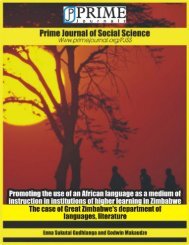<strong>Prime</strong> Journal of Business Administration and Management (BAM)ISSN: 2251-1261. Vol. 3(6), pp. 1043-1046, June 26 th , 2013www.primejournal.org/BAM© <strong>Prime</strong> <strong>Journals</strong>Review PaperStrategic management of urbanization and rural urbanmigration problem in poor regions: A review of thedynamics<strong>Oyat</strong> ChristopherSenior lecturer, Department of Development Studies, Gulu University, Uganda.Accepted 15 th June, 2013Policy makers and technocrats in charge of urban authorities should appreciate the fact that urbanization andrural-urban migration phenomena is real in developing countries, and the problems and challenges embeddedtherein should be strategically and proactively tackled. It is emphasized that there should not be discriminationby way of compelling without proper plan the urban poor to recede and occupy rural areas as if towns andcities are meant for only the well-to-do people. Equally vital is the fact that development actors such as nongovernmentalorganizations and United Nations agencies should unequivocally render capacity buildingsupport with similar magnitude provided to the ruralites. All stakeholders in towns and cities have obligationsto ensure that urban livelihood services and the general infrastructures are improved for the mutual benefit ofthe entire town dwellers.Key words: Urbanization, migration and poverty.INTRODUCTION AND BACKGROUNDUrbanization is looked at as a process by which anincreasing proportion of the population becomesconcentrated in urban centres. The trend in the worldshows that urban centres and urban population havebeen increasing tremendously, for example in 1800, therewere only 3% of the population living in urban areas. By1900, the population had increased to 13%. In 2002, it isdocumented that world urban population stood at about50%. In the case of Uganda, and in accordance with2002 census, 12% of the total population lived in urbancentres.Table 1 clearly shows that there has been a generalstudy rise in the urban population worldwide. But ofspecific note is the trend in less developed regionsespecially in Africa and Asia of late. Whereas the worldurban population and that of more developed regionshave been increasing since 1950 and projected as shownabove, come 2025, it is interesting that the rate ofurbanization and rural-urban migration appears to befaster in less developed regions of the world (Todaro,2003).Urban scholars and development economists havenoted that urban population generally engage in nonagriculturalactivities like industrial, institutional andcommercial activities. And because of high urbanizationand population growth world over, there has been atendency to destroy objects, degrade soil, cut trees andcultivate more land to meet farmers’ demand of the everincreasing urban population.To meet the needs of burgeoning urban populations,stimulate both urban and rural development and achievemillennium development goals (MDGs), planners andpolicy makers should reconsider some of their biasesagainst urban growth. The world over, it is evident thaturbanization and rural urban migration can play a positiverole in social and economic development (UNFPAReport, 2007). Historically, the statistical associationbetween urbanization and economic growth has beenstrong. Today, cities and towns generally have greaterpotential for sustained development than rural areas,especially when look at the potential for reducing poverty.It is a fact that cities and towns are the main sites foreconomic growth in most countries, and do account for ahigh share of national economic production. It is arguedthat countries that are highly urbanized tend to havehigher incomes, more stable economies, stronger
<strong>Oyat</strong> 1044Table 1: Urban population in major world regions from 1950 – 2025 (in millions and billions)Region 1950 1960 1970 1980 1995 2000 (a) 2025 (b)World 724 1012 1352 1807 2584 3208 5065More developed regions 449 573 698 834 875 965 1040Less developed regions 275 439 654 972 1709 2101 4025Africa 32 50 83 133 250 331 804Latin America 68 107 162 241 358 431 601Asia 218 342 407 596 1101 1291 2615Source: United Nations, patterns of urban and rural population growth, New York, 1980.institutions and are better able to withstand the volatilityof global economy (UNFPA, Report 2007).It is commonly assumed that rural - urban migrationmerely redistributes poverty from the country side to thecities and towns. Yet, social mobility commonlyaccompanies migration, and poverty rates have beendeclining in both the rural and urban areas of manycountries. In Bolivia, urbanization accounted for 28.3% ofthe 1.2 percent reduction in the national poverty levelduring the 1999 – 2005 period; 17% of the Brazil’s 5.1%poverty reduction between 1999 and 2004 was similarlydue to urbanization and rural –urban migration. InNicaragua, urban and rural poverty levels hardly changedat all between 1998 and 2001; yet the national povertylevel fell over half a percentage point as a result ofurbanization.Although this descriptive exercise does not provideconclusive evidence as to whether urbanization has anindependent role in promoting poverty reduction, it doessuggest that given the right conditions, it can be adynamic component of national poverty reductionprocess, rather than being a mere escape valve for ruralpoverty.The reluctance of policy makers including a bid toaccept urbanization has been a barrier against the flow ofadvances promoted by urban social movements. Inrecent years, local organizations of the urban poor(OUPs) and NGOs have made remarkable headway incollective efforts to improve housing infrastructure andgeneral services thereby greatly alleviating and reducingurban poverty. Their efforts are being greatly recognizedtoday; the 2006 United Nations Habitat Conference was,in many ways, a celebration of their success. Yet localcommunities have often had to overcome obstacles putup by local and national authorities, when a moresupportive approach could have made a crucialdifference! To help urbanization and rural urban migrationmove in the right direction, policy makers need to revisethe assumptions that underlie their anti-urban bias. Theyshould be able not only to move with the flow of thecurrent actions adopted by a number of nations ininfrastructural development, but also to direct the processof socio-economic development towards improving theurban habitat and reducing poverty.Trying to lock out the massesIt is documented that several national governments indeveloping countries have tried to keep or restrict therapid expansion of urban settlements for the poor by;- Ambitious schemes to retain people in rural areas or tocolonize new agricultural zones; and- Regulating urban land use, backed up either byevictions or more frequently by denying essentialservices such as water and sanitation.The arguments that portray excessive rural-urbanmigration as a cause of urban poverty are typically basedon a number of misconceptions as follows:1) Rural-urban migrants are primarily responsible forurban poverty;2) Focusing on urban poverty can detract attention fromrural development;3) Population growth in cities and towns is what causesslums;4) The poor are a drain on the urban economy;5) Migrants would be better off remaining in rural areas;and6) Rural –urban migration policies can limit urban growth(UNFPA, 2007).Policy makers and technocrats alike should note that wellintentioned mobility is a strategy that several householdsand individuals adopt to improve their lives and to reducerisks and vulnerability in society. In many regions peopleare forced to leave rural areas due to, for example,environmental changes, insecurity and the search forbetter livelihood conditions of engagement. Urbanauthorities and central Governments should strengthentheir capacities to respond to the pressures caused byrapid urbanization. Particular attention should be paid toland management in order to ensure economical landuse, protect fragile ecosystems and facilitate the accessof the poor to land in urban and rural area alike withoutdiscrimination.Study approachThis study benefits heavily from the fact that theresearcher had worked as central Government appointedChief Executive Officer (Town Clerk) of various urban





![See Full Article [pdf] - prime journals limited](https://img.yumpu.com/49292987/1/190x245/see-full-article-pdf-prime-journals-limited.jpg?quality=85)



![See Full Article [pdf] - Prime Journals](https://img.yumpu.com/44526114/1/190x245/see-full-article-pdf-prime-journals.jpg?quality=85)


![See Full Article [pdf] - prime journals limited](https://img.yumpu.com/42270022/1/190x245/see-full-article-pdf-prime-journals-limited.jpg?quality=85)
![See Full Article [pdf] - Prime Journals](https://img.yumpu.com/41607332/1/190x245/see-full-article-pdf-prime-journals.jpg?quality=85)
![See Full Article [pdf] - Prime Journals](https://img.yumpu.com/41231982/1/190x245/see-full-article-pdf-prime-journals.jpg?quality=85)

